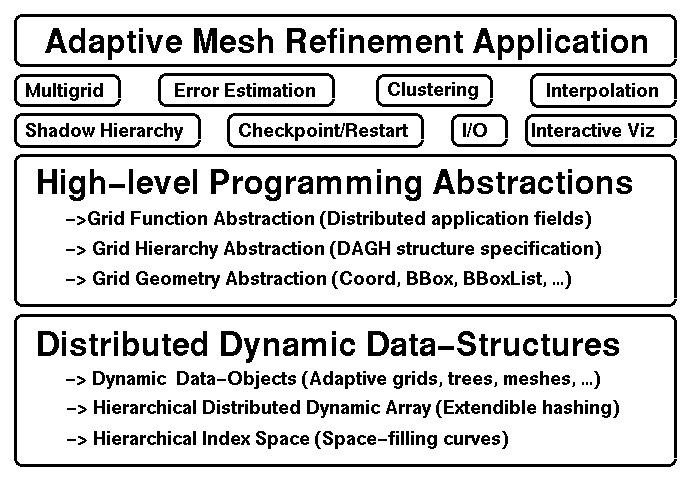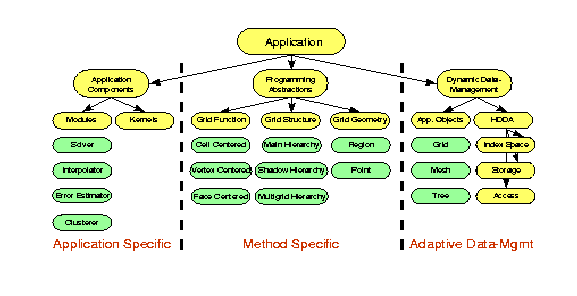
DAGH provides a program development infrastructure for implementation of solutions of partial differential equations using adaptive mesh refinement algorithms. The principles of hierarchical abstraction and separation of concerns were incorporated into the development of DAGH.

Figure 2 is a schematic design model for DAGH. Each level can be thought of as a set of abstract data types. The lowest level defines a hierarchical dynamic distributed array (HDDA) that is a generalization of the familiar static array. It has the operations of creation, deletion, array expansion and contraction, and array element access defined on it.
We illustrate the separation of concerns by defining a separate level (above HDDA) to implement grids and/or meshes. This abstraction level implements grids by instantiating arrays as components of grids. In the definition of grids are the operations of creation, deletion, expansion, and contraction. These operations are directly translated to operations on instances of HDDA. The definition of grids also includes computational operators, partitioning operators, refinement and coarsening operators, etc.

Figure 3 is another schematic diagram of the levels of abstraction in DAGH. But in this figure the hierarchy descends from left to right. Each level of the hierarchy is given in more detail from top to bottom.
An application consists of specific components. These components are mapped to operations on appropriate subtypes on their right in the programming abstraction layer. The grid subtypes are mapped to the types implemented by the dynamic data management layers to their right.
The Grid Structure abstractions define hierarchical grids and implement standard operations on these grids. These abstractions represent the structure of the geometry of the computational domain. The Grid Function abstractions define application fields on the Grid Structure. These abstractions define the data storage associated with a grid structure. This separation of Grid Function from Grid Hierarchy enables the structure of the computational domain to be defined and manipulated independent of the computational data.
The Grid Geometry abstractions represent regions in grid space that are independent of grid type. These abstractions provide the means for interacting with grids and addressing and directing computations to regions on the grids.
Hierarchical Dynamic Distributed Array (HDDA) is the data structure abstraction used in DAGH. HDDA is an array data type that has the operations of creation, deletion, array expansion and contraction, and array element access and storage defined on it. Separation of concerns applies vertically within the definition of HDDA. HDDA is composed of three abstractions: index spaces, storage, and access.
Data storage is implemented using extendible hashing techniques to provide a dynamically extendible, globally indexed storage. Entries in the HDDA correspond to DAGH blocks. Each block in the list is assigned a cost corresponding to its computational load. The grid hierarchy can be partitioned by appropriately partitioning the linear representation of a DAGH instance across processors so as to balance the computational cost associated with each processor.
DAGH provides the class libraries needed to implement adaptive mesh refinement methods and to run a program on parallel processors. All programs that use DAGH have a common structure. This structure can be viewed as a template for application dependent routines which are supplied by the user. To create a DAGH-based application you have to provide -
The driver is a C or C++ program (although drivers can be written in Fortran this option is not discussed in the tutorial). The driver needs to be compiled. One usually uses a makefile to do the compilation. After compilation you can run the executable code on a single processor or use MPI to run it on several processors. The top level view of the structure of the driver is as follows:
The DAGH interface includes:
An instance of DAGH typically includes: